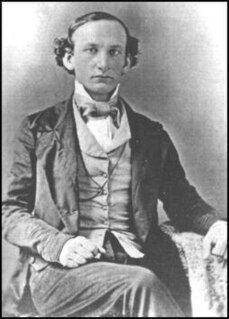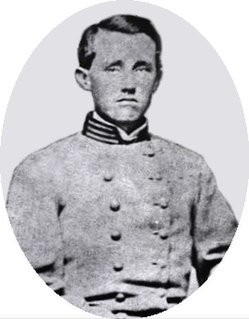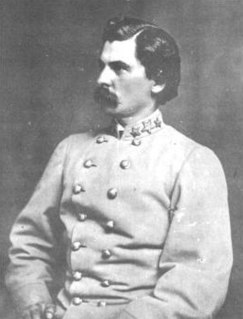
Thomas Taylor Munford was an American farmer, iron, steel and mining company executive and Confederate colonel and acting brigadier general during the American Civil War.

Arthur Pendleton Bagby Jr. was an American lawyer, editor, and Confederate States Army colonel during the American Civil War. Confederate General E. Kirby Smith, commander of the Trans-Mississippi Department assigned Bagby to duty as a brigadier general on April 13, 1864 to date from March 17, 1864 and as a major general on May 16, 1865. These extra-legal appointments were not made official by appointments of Bagby to general officer grade by Confederate President Jefferson Davis or by confirmation by the Confederate Senate.

Pinckney Downie Bowles was a lawyer, county prosecutor, probate judge, and a Confederate military officer during the American Civil War.

John Dunovant was a brigadier general with temporary rank in the Confederate States Army during the American Civil War. Dunovant was a native of South Carolina who had been a Mexican–American War veteran and captain in the U.S. Army from March 3, 1855 to December 29, 1860. During the Civil War, he was commander of the 1st South Carolina Regulars and later the 5th South Carolina Cavalry Regiment. He was in command of a cavalry brigade in the later part of the Overland Campaign and the early part of the Siege of Petersburg. He was killed at the Battle of Vaughan Road on October 1, 1864 during the Siege of Petersburg.

William Montgomery Gardner was a Confederate States Army brigadier general, during the American Civil War. Before the Civil War, he served in the U.S. Army for 15 years. He was a veteran of the Mexican–American War.

Nathaniel Harrison Harris was a Confederate States Army brigadier general during the American Civil War.

James Edward Harrison was a Confederate States Army brigadier general during the American Civil War. He served in the Trans-Mississippi Department and fought in campaigns in Louisiana. Before the war, he was a two-term Mississippi state senator before moving to Texas in 1857. After the war, he was a trustee of Baylor University.

Edward Higgins was a Confederate States Army brigadier general during the American Civil War. Before the war, he spent almost 20 years in the United States Navy and 7 years as a merchant steamship agent. After the war, he was an insurance and import sales agent at Norfolk, Virginia and from 1872 to 1875 was an agent for the Pacific Mail Steamship Company.

Young Marshall Moody was a Confederate States Army officer who was promoted to brigadier general near the end of the American Civil War. He was a teacher, merchant, and circuit court clerk in Marengo County, Alabama, before the war. He died from yellow fever during a business trip to New Orleans, Louisiana, on September 18, 1866.

Daniel Harris Reynolds was a Confederate States Army brigadier general during the American Civil War. He was born at Centerburg, Ohio but moved to Iowa, Tennessee and finally to Arkansas before the Civil War. He was a lawyer in Arkansas before the war. After the war, Reynolds resumed his practice of law and was a member of the Arkansas Senate for one term.

John Caldwell Calhoun Sanders was one the Confederate States Army's youngest brigadier generals during the American Civil War. He was killed in the Battle of Globe Tavern along the Weldon Railroad during the Siege of Petersburg, Virginia on August 21, 1864.

Clement Hoffman Stevens was a Confederate States Army brigadier general during the American Civil War. He designed and constructed the iron-clad battery on Morris Island at the mouth of Charleston Harbor which was used in the bombardment of Fort Sumter at the outbreak of the Civil War. He was killed in action at the Battle of Peachtree Creek during the Atlanta Campaign.

Henry Harrison Walker was a Confederate States Army brigadier general during the American Civil War. He was born in Sussex County, Virginia. He graduated from the United States Military Academy at West Point, New York in 1853 and served as an officer in the United States Army from 1853 to 1861. Walker was wounded twice during the war and lost his left foot. After the war, he became a stockbroker at Morristown, New Jersey where he lived until 1912.

William Stephen Walker was a Confederate States Army brigadier general during the American Civil War. He was born in Pittsburgh, Pennsylvania but was raised by Robert J. Walker, his uncle, who was a Secretary of the Treasury and U.S. Senator. Walker served as a first lieutenant in the United States Army during the Mexican–American War from 1847 to 1848. He was discharged in 1848. Walker rejoined the army as captain in the 1st U.S. Cavalry Regiment on March 3, 1855 and served until he resigned on May 1, 1861. Walker was wounded in the left arm and lost his left foot during the Battle of Ware Bottom Church during the Overland Campaign. After the war, he lived at Atlanta, Georgia.

David Addison Weisiger was a Confederate States Army brigadier general during the American Civil War. Weisiger served as a second lieutenant in the 1st Virginia Volunteers, an infantry regiment, during the Mexican–American War. After the war, he was a businessman at Petersburg, Virginia. Between 1853 and 1860, he served in the 39th Virginia Militia Regiment, rising from captain to colonel. After the Civil War, he was a bank cashier at Petersburg, Virginia and a businessman at Richmond, Virginia.
Wilburn Hill King was a Confederate States Army colonel during the American Civil War. He was assigned to duty as a brigadier general by General E. Kirby Smith but he was not officially appointed and confirmed to that grade.
Levin Major Lewis was a Confederate States Army colonel during the American Civil War. On May 16, 1865, he was assigned to duty as a brigadier general by General E. Kirby Smith when the war even in the Trans-Mississippi Department was almost over, but he was not officially appointed by Confederate President Jefferson Davis and confirmed by the Confederate Senate to that grade.

Henry Marshall Ashby was a Confederate States Army colonel during the American Civil War. Although he commanded a brigade from June 1864 and a division at the Battle of Bentonville and through the surrender of the Confederate force under the command of General Joseph E. Johnston, he was never appointed a brigadier general by Confederate President Jefferson Davis or confirmed as a general officer by the Confederate Senate.

James Hagan was a United States Army captain during the Mexican–American War and a Confederate States Army colonel during the American Civil War. He was a prosperous businessman and planter at Mobile, Alabama between the wars.
Moses Wright Hannon was a Confederate States Army colonel during the American Civil War. In August 1864, he was assigned to duty as an acting brigadier general by General John Bell Hood, subject to appointment by Confederate President Jefferson Davis and confirmation by the Confederate Senate. Although Hannon commanded a brigade in the cavalry corps of the Army of Tennessee and in Major General Joseph Wheeler's cavalry corps from June 1864 until the end of the war, he never was officially appointed by Jefferson Davis and confirmed by the Confederate Senate to brigadier general rank.































